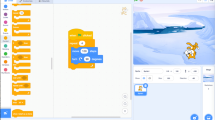Abstract
Collaborative problem-solving (CPS) is important in today’s fast-paced and interconnected world. However, assessing and supporting CPS skills and actions in online and co-located collaborative settings is challenging for researchers and teachers. To identify individual and group CPS behavioral patterns, this study employs epistemic network analysis (ENA) in analyzing, modeling, and visualizing the collaborative discourse patterns of legal students working on an ill-structured problem in a semester-long course. The results showed that individual students’ CPS strategies differed across the two meetings, and demonstrated varying standards for cognitive and metacognitive regulation processes. We provide implications for researchers and teachers working in CPS environments and underscore the need for multimodal datasets to understand students’ CPS strategies clearly.
Access this chapter
Tax calculation will be finalised at checkout
Purchases are for personal use only
Similar content being viewed by others
References
OECD: What is collaborative problem-solving? In: PISA 2015 (vol. V): Collaborative Problem Solving. OECD, Paris (2017)
Haste, H.: Ambiguity, autonomy and agency: Psychological challenges to new competence. In: Defining and Selecting Key Competencies, pp. 93–120. Hogrefe & Huber (2001)
Littleton, K., Miell, D., Faulkner, D.: Learning to Collaborate, Collaborating to Learn: Understanding and Promoting Educationally Productive Collaborative Work. Nova Science Publishers Inc. (2004)
Cukurova, M., Luckin, R., Millán, E., Mavrikis, M.: The NISPI framework: analysing collaborative problem-solving from students’ physical interactions. Comput. Educ. 116, 93–109 (2018)
Pardo, A., Poquet, O., Martínez-Maldonado, R., Dawson, S.: Provision of data-driven student feedback in LA & EDM. In: Lang, C., Siemens, G., Wise, A., Gasevic, D (eds.) Handbook of Learning Analytics. Society for Learning Analytics Research (SoLAR), pp. 163–174 (2017)
Swiecki, Z., Ruis, A.R., Farrell, C., Shaffer, D.W.: Assessing individual contributions to collaborative problem solving: a network analysis approach. Comput. Hum. Behav. 104, 105876 (2020)
Kyllonen, P.C., Zhu, M., von Davier, A.A.: Introduction: innovative assessment of collaboration. In: von Davier, A.A., Zhu, M., Kyllonen, P.C. (eds.) Innovative Assessment of Collaboration, pp. 1–18. Springer International Publishing, Cham (2017). https://doi.org/10.1007/978-3-319-33261-1_1
Echeverria, V., Martinez-Maldonado, R., Buckingham Shum, S.: Towards collaboration translucence: Giving meaning to multimodal group data. Paper presented at the Proceedings of the 2019 CHI Conference on Human Factors in Computing System (2019)
Stahl, G., Hakkarainen, K.: Theories of CSCL. In: Cress, Ul., Rosé, C., Wise, A.F., Oshima, J. (eds.) International handbook of computer-supported collaborative learning. CCLS, vol. 19, pp. 23–43. Springer, Cham (2021). https://doi.org/10.1007/978-3-030-65291-3_2
Tan, Y., Ruis, A. R., Marquart, C., Cai, Z., Knowles, M.A., Shaffer, D.W.: Ordered network analysis. In: Advances in Quantitative Ethnography: 4th International Conference, ICQE 2022, Copenhagen, Denmark, 15–19 Oct 2022, Proceedings, pp. 101–116. Springer Nature Switzerland, Cham (2023)
Wang, Y., Ruis, A.R., Shaffer, D.W.: Modeling Collaborative Discourse with ENA Using a Probabilistic Function. In: Advances in Quantitative Ethnography: 4th International Conference, ICQE 2022, Copenhagen, Denmark, 15–19 Oct 2022, Proceedings, pp. 132–145. Springer Nature Switzerland.- check paper, Cham (2023)
Zimmerman, B.J., Martinez-Pons, M.: Student differences in self-regulated learning: relating grade, sex, and giftedness to self-efficacy and strategy use. J. Educ. Psychol. 82(1), 51 (1990)
Roschelle, J., Teasley, S.D.: The construction of shared knowledge in collaborative problem solving. In: O’Malley, C. (ed.) Computer Supported Collaborative Learning, pp. 69–97. Springer Berlin Heidelberg, Berlin, Heidelberg (1995). https://doi.org/10.1007/978-3-642-85098-1_5
Malmberg, J., Järvelä, S., Järvenoja, H.: Capturing temporal and sequential patterns of self-, co-, and socially shared regulation in the context of collaborative learning. Contemp. Educ. Psychol. 49, 160–174 (2017)
Zimmerman, B.J.: Self-regulated learning and academic achievement: an overview. Educ. Psychol. 25(1), 3–17 (1990)
Jivet, I., Wong, J., Scheffel, M., Valle Torre, M., Specht, M., Drachsler, H.: Quantum of Choice: how learners’ feedback monitoring decisions, goals and self-regulated learning skills are related. In: LAK21: 11th International Learning Analytics and Knowledge Conference, pp. 416–427 (2021)
Zimmerman, B.J., Schunk, D.H.: Handbook of Self-Regulation of Learning and Performance. Routledge/Taylor & Francis Group (2011)
Siebert-Evenstone, A.L., Irgens, G.A., Collier, W., Swiecki, Z., Ruis, A.R., Shaffer, D.W.: In search of conversational grain size: Modeling semantic structure using moving stanza windows. J. Learn. Anal. 4(3), 123–139 (2017)
Shaffer, D.W., Collier, W., Ruis, A.R.: A tutorial on epistemic network analysis: analyzing the structure of connections in cognitive, social, and interaction data. J. Learn. Anal. 3(3), 9–45 (2016)
Johansen, S.H.: A contrastive approach to the types of hedging strategies used in Norwegian and English informal spoken conversations. Contrastive Pragmatics 2(1), 81–105 (2020)
Winne, P.H.: Self-regulated learning: In: International Encyclopedia of the Social & Behavioral Sciences, pp. 535–540. Elsevier (2015)
Author information
Authors and Affiliations
Corresponding author
Editor information
Editors and Affiliations
Rights and permissions
Copyright information
© 2023 The Author(s), under exclusive license to Springer Nature Switzerland AG
About this paper
Cite this paper
Kaliisa, R., Dane, J.O., Sanchez, D., Pratt, J., Damsa, C., Scianna, J. (2023). Understanding Group Dynamics During Synchronous Collaborative Problem-Solving Activities: An Epistemic Network Approach. In: Arastoopour Irgens, G., Knight, S. (eds) Advances in Quantitative Ethnography. ICQE 2023. Communications in Computer and Information Science, vol 1895. Springer, Cham. https://doi.org/10.1007/978-3-031-47014-1_6
Download citation
DOI: https://doi.org/10.1007/978-3-031-47014-1_6
Published:
Publisher Name: Springer, Cham
Print ISBN: 978-3-031-47013-4
Online ISBN: 978-3-031-47014-1
eBook Packages: Computer ScienceComputer Science (R0)



